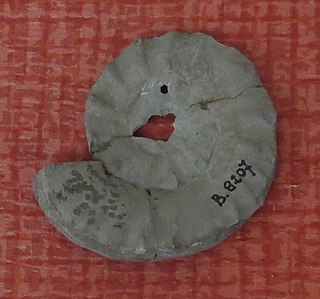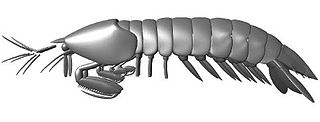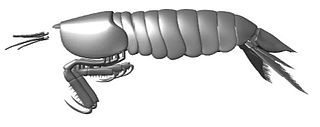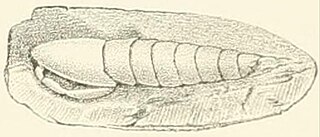
Aeger is a genus of fossil prawns. They first occur in the Early Triassic, and died out at the end of the Late Cretaceous. A total of 21 species are known.

The Early Triassic is the first of three epochs of the Triassic Period of the geologic timescale. It spans the time between 251.9 Ma and 247.2 Ma. Rocks from this epoch are collectively known as the Lower Triassic Series, which is a unit in chronostratigraphy. The Early Triassic is the oldest epoch of the Mesozoic Era. It is preceded by the Lopingian Epoch and followed by the Middle Triassic Epoch. The Early Triassic is divided into the Induan and Olenekian ages. The Induan is subdivided into the Griesbachian and Dienerian subages and the Olenekian is subdivided into the Smithian and Spathian subages.

In the geologic timescale, the Olenekian is an age in the Early Triassic epoch; in chronostratigraphy, it is a stage in the Lower Triassic series. It spans the time between 251.2 Ma and 247.2 Ma. The Olenekian is sometimes divided into the Smithian and the Spathian subages or substages. The Olenekian follows the Induan and is followed by the Anisian.

Aegeridae is a family of fossil prawns, one of the earliest Mesozoic shrimp families. It contains the genera Aeger, Acanthochirana, Anisaeger and Distaeger. The main diagnostic character of Aegeridae is the presence of numerous spines or thin setae on the third maxilliped.
The Thaynes Group, Thaynes Formation in older literature, is a geologic group in eastern Idaho, western Wyoming, Utah and eastern Nevada. It includes the Sinbad Formation, Virgin Formation and Shnabkaib Formation. The Thaynes Group is of marine origin. Its formations are interbedded with layers of the non-marine Moenkopi Group.

Tirolites is an extinct genus of ammonoid cephalopod. Its first appearance defines the Smithian-Spathian boundary in the Olenekian stage of the Early Triassic epoch. It is prominent in the Paris biota.
The Guiyang biota is an exceptionally preserved Early Triassic fossil assemblage from the Daye Formation near Guiyang (China), discovered between 2015 and 2019 and first reported in 2023. It is the oldest known Mesozoic lagerstätte, and it provides evidence of the existence of a complex marine ecosystem shortly after the Permian–Triassic extinction event.
Anisaeger is a genus of fossil prawns first described from the Luoping biota of the middle Triassic of China but also known from the Guiyang biota and Paris biota of the early Triassic. It includes three species, A. brevirostrus, A. longirostrus and A. spiniferus.
The Paris biota is an exceptionally diverse Early Triassic fossil assemblage described in 2017 from the Lower Shale Member of the Thaynes Group. It was first discovered in Paris Canyon, west of the town of Paris in Bear Lake County, southeastern Idaho, United States. This biota was later also found in coeval and slightly younger beds in northeastern Nevada and Bear Lake and Caribou counties, southeastern Idaho.

Tyrannosculda is an extinct genus of mantis shrimp which lived during the Late Jurassic in southern Germany. It was named in 2021, with T. laurae as the type and only species. Several fossil specimens are known, representing various growth stages.

Tyrannophontes is an extinct genus of mantis shrimp that lived during the late Carboniferous period in what is now the Mazon Creek fossil beds of Illinois. It is the only genus in the family Tyrannophontidae. The type species, T. theridion, was described in 1969 by Frederick Schram. A second, much larger species, T. gigantion, was also named by Schram in 2007. Two other species were formerly assigned to the genus, but have since been reclassified.

Daidal is an extinct genus of mantis shrimp that lived during the Carboniferous period. It is the only genus in the family Daidalidae. Three species are currently placed within the genus. Fossils of the type species, D. acanthocercus, have been found in the Bear Gulch Limestone of Montana. A second species, D. pattoni, is known from the Lower Limestone Formation of Scotland, and the third species, D. schoellmanni, was discovered in Westphalia, Germany. The genus has been proposed to be polyphyletic, with D. pattoni possibly being an earlier diverging lineage, though more specimens and research are needed to confirm this.

Sculda is an extinct genus of mantis shrimp known from the late Jurassic to late Cretaceous of Germany and Lebanon. Although several species have been assigned to it, some are now deemed dubious or moved to different genera. It was a moderate-sized crustacean, measuring no more than 50 mm (2.0 in) long. Sculda would have lived in a marine environment and been a predatory animal, likely smashing its prey with the widened segment of its raptorial appendages before cutting it with the sharp appendage tips.

Sculdidae is a family of fossil mantis shrimps which lived from the late Jurassic to late Cretaceous periods. It was erected in 1886 to contain the type genus Sculda, and other genera have since been assigned to it. Fossils of sculdids have been found in Germany, Lebanon and the United States. The family may be polyphyletic.

Gorgonophontes is an extinct genus of mantis shrimp that lived during the late Carboniferous period in what is now the United States and Belgium. It contains two named species. The type species, G. peleron, was described in 1984 by Frederick Schram based on 100 specimens found in Nebraska and Iowa. A second species, G. fraiponti, was first named from multiple specimens found near Liège in 1922 and later reassigned to the genus.
Chabardella is an extinct genus of mantis shrimp which lived during the Late Carboniferous in France. It was named in 2009, with C. spinosa as the type and only species.

Gorgonophontidae is a family of fossil mantis shrimps which lived from the Moscovian to Gzhelian stages of the Carboniferous period. It was erected in 2007 as a monotypic group by Frederick Schram to contain only the type genus Gorgonophontes. A second genus, Chabardella, was assigned to the family in 2009. Fossils of gorgonophontids have been found in France, Belgium and the United States. The family may be polyphyletic.

Archaeocaris is an extinct genus of mantis shrimp that lived in North America during the Early Carboniferous period. Though it was placed as a member of the family Perimecturidae until 2008, it is currently deemed the only genus in the family Archaeocarididae, and contains two species. The type species, A. vermiformis, was described by Fielding Bradford Meek in 1872 from specimens collected at the base of the Waverly Group in Kentucky. A second species, A. graffhami, was named by Harold Kelly Brooks in 1962 based on a fossil found in the Caney Shale of Oklahoma, with additional remains later found in the Pilot Shale of Nevada.
Nodosculda is an extinct genus of mantis shrimp that lived in North America during the late Albian stage of the Early Cretaceous period, between 105 and 100 million years ago. The only species is Nodosculda fisherorum, known from several specimens uncovered in the Paw Paw Formation of Texas.
Ursquilla is an extinct genus of mantis shrimp that lived in Israel and Jordan during the Campanian stage of the Late Cretaceous period. It contains a single species, Ursquilla yehoachi.









